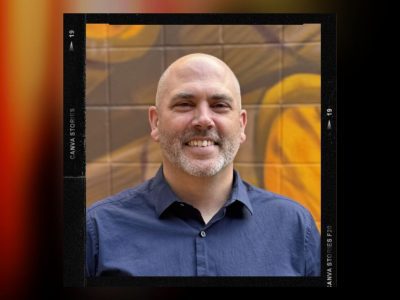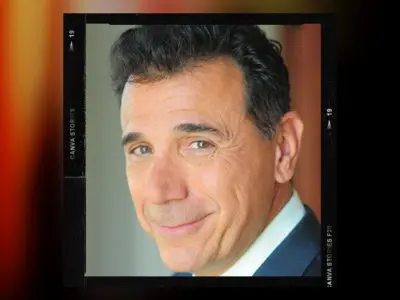The Impact of Remote Work on Climate Change
w/ Andrea Burgess
Use the buttons above to listen now.
Transcript - The Impact of Remote Work on Climate Change
Rich: On this episode of team building saves the world.
Andrea: Do you want your business to be around in 50 years? Do you want it to be here a hundred years? We on the path that we are on are kind of screwed. I can also wear pajama pants whenever I’m doing podcast interview you have happier employees, you have healthier employees, you have better profits, you have bigger customer bases
I really don’t know. What the hesitation
Rich: Hello team. It’s me, your old friend. Rich Rininsland. Host of team building saves the world. The show where I speak to the leaders and innovators of the team, building industry from all across the globe, trying to find out what about that industry is so important, especially in the world of today. And today we’re looking at the environmental impact of remote work with writer and researcher, Andrea Burgess.
But first I need to share some love with my supporters of team bonding. If your team is ready to experience teamwork through the power of play, the visit team bonding.com to learn more. And now teams, please join me in welcoming a writer and researcher with Alliance, virtual offices, Andrea Burgess,
and Andrea. That is just a small group of people. I keep chained up into my desk just to applaud you. How are you today?
Andrea: Great. How are you?
Rich: I’m great. Thank you for asking. So we’re talking about environmental impacts for the stay at home worker for remote. I guess the first question just to ask is, do we know about how many people currently in the U S or worldwide are actually at home working
right now?
Andrea: That’s a difficult question to answer because there are still some after effects of the pandemic happening. So that number is kind of in flux. You know, when at the height of the pandemic, pretty much anyone who wasn’t an essential worker was working from home. Um, now a lot of that is being phased out. So it’s kind of, it’s a little bit hard to say an exact number, but there are a lot of companies that have embraced remote work and especially hybrid working models.
Rich: I should also let everybody else know out there that you have a guest with you Peach
Andrea: yes, this is my dog, my dog, princess peach. She loves being a guest star on interviews and podcasts. She always thinks that we’re talking to her as well, so she will probably be cute throughout this entire meeting.
Rich: Okay. So let’s talk about that impact.
What are some of the impacts that we are seeing of.
Andrea: Well, we know that remote workers, um, those who re reduce their commute to zero, who worked from home remotely a hundred percent of the time that they are approximately reduce their carbon footprint by 1800 pounds. So that’s a big savings. We also know that waste production whenever you’re not working in an office for some reason, Throw a lot more garbage away whenever somebody else is taking out the trash.
So, additionally, uh, things like printing papers, a lot of people, if they have printers at home, they want to use those more sparingly because cartridges are expensive. And, you know, if we can have it pulled up on your home desk at the time that you want, you don’t really need a printed out copy. So people are using a lot less paper producing, a lot less trash and the.
Environmental effects of running a large business, rather than just running the AC or the heater in your home. It’s a lot more environmentally friendly than working in an office.
Rich: So, what else are we looking at? Because like you said, just the reduction of the carbon impact. Do we know exactly how much like drive time has been eliminated through remote working?
Andrea: I believe I can’t quote you as a statistic on that right this minute, but I believe the average drive time is somewhere between 19 and 24 minutes. Okay. One way per employee. So right now, for me specifically the two in-person jobs that I have, I drive 19 minutes for one and 56 minutes for another. So, you know, if I go back to working 100%, um, remotely, then that would be two, almost three hours of a reduction in commute time per week, per day.
Rich: So this sounds so far like a big positive like we’ll look like we’re looking at a great reduction. What was it beforehand? Like what did we see early on in the pandemic that was making everybody kind of excited? Not only to be working from home because they get to be home. But, but also environmentally, because I know there was a lot of talk about the environmental impact that was happening then like March 20 20.
Andrea: Um, well, we did see an uptick of greenhouse gases due to working from home. But if you take that number compared to the amount of greenhouse gas emissions that we had just prior to that, it is significantly less. So one of the cases that statistics that we had is saying that a forest of over 70,000 square miles would need to be planted to offset the environmental impact of working from home.
But that is still about a 67% drop from what it would be if all of those people were still working in the office.
Rich: Gotcha. All right. I looked up some things before we came on and I’m seeing that like, it’s estimated that one in four. Are currently working from home and we’ll be through 2021. What are we currently still seeing?
What is, what is maintaining now as opposed to what it was in the.
Andrea: From what it was in the beginning, there are obviously, you know, people are getting back into the new sense of normalcy, but we still do have a lower, I think it’s two to 3% lower carbon dioxide emissions. Then we did, whenever everyone was forced to work in the office a hundred percent of the time and not only the environmental impact, but a lot of consumers.
Are looking for companies that are environmentally conscious that allow their, their workers a good quality of life. And in addition to the, um, better quality of life, but also, you know, working from home is more environmentally friendly. So the consumers are looking for companies that do that type of thing.
So those big businesses that are offering these new hybrid models, they’re seen as more environmentally friendly and they’re getting an uptick and customer loyalty. And increased customer base and higher returns.
Rich: So why is that? Why is that happening? Especially the customer.
Andrea: Uh, because the customers, these days, especially millennials, which are, you know, one of the, the largest consumer population tied pretty much close, tied with boomers, but are a lot more conscious about where they’re putting their dollars.
I mean, we don’t have a lot of dollars to put out there. So we want to make sure that we’re supporting companies that are going to be. Earth friendly that are good to their employees. Like a place that you would want to work, um, that you want to support, that they treat their employees well. And that kind of brand awareness, that kind of awareness of what companies are doing behind the scenes rather than just their, their profits and that gains that are, are promoted and news media and things like that.
Like people are looking into that. That’s important to a lot to a larger and larger percentage of buyers.
Rich: So you had mentioned the ups spike that we have noticed from remote work. What are people doing at home that’s causing.
Andrea: Well, a lot of times, whenever people leave the house for work, they, they turn their heating and cooling systems to a more friendly degree.
They don’t use as much lighting. They eat out a lot more. So there’s more people who are cooking on gas, stoves and electric stove. So using those resources, the one thing that people can definitely do to help offset that is, you know, maybe set the thermostat a couple degrees. Cooler or warmer than you would normally have it don’t light the whole house.
If you’re only going to be working in your office. Right. Um, especially cut out the uses of, um, like paper products, paper plates, plastic cups, use things that are reusable. So that is a few things that people can do to help within their work from home environments to even be more environment environmentally friendly.
Rich: It sounds like this is all coming across as positives. Yes. Yep. We’re, we’re kind of being sold depending upon who you’re listening to, that this is a negative it’s time to get people back to work, meaning back in the office. Right. Why are we here? Why is this what we’re hearing as opposed to congratulations everybody we’re coming this much closer to solving
greenhouse emission, right?
Andrea: Right. There is a large percentage of people, especially in management who feel their employees lack accountability. Whenever they don’t have a boss sitting over their shoulder all at the time. That’s that’s one reason. Another reason does actually come from workers. And this is something that I’ve been investigating on the new study that we’re doing about, um, employee wellbeing and working from home.
And interestingly, most, uh, the majority of workers who say, I don’t want to work at home anymore. I want to go back to the office are young men. Who are afraid that their contributions and their, their hard work and their dedication is not going to be seen by upper management as a way of promotion whenever they’re not directly in the line of sight of the people that are making these decisions.
Yeah.
Rich: Interesting. And is there anything that, like, is this something corporations are actually taking into consideration?
Andrea: I haven’t got to that point and, and the, the research project that I’m working on, I would assume. Yes, I would assume. Yes, that that is something that there, because you know, that’s the way that we’re used to working.
Now, if it was an equal playing field, if everyone was treated equally, whenever they were working from home, then that kind of thing wouldn’t matter. Like the, the results that you produced should speak for them. But we all know that the world is not a hundred percent fair and the playing field is not equal for everyone.
So I do think that it presents a valid concern. I just think that it’s very interesting that that female employees seem to be less concerned about that type of thing
Rich: And that is whole different podcast topic entirely. But actually, Andrea, if you don’t mind, I’m going to step away just for a quick second.
Because they need to take a minute to tell my friends out there about a company I’m very proud to be a part of team bonding team bonding was founded over 20 years ago with one simple question. How can employees have a great time while fostering strong, authentic bonds between people who work together?
They’ve created a catalog of innovative events using the power of play as a learning tool and tapping into the correlation of work and. From scavenger hunts to jeopardy and so much more the team bonding of activities live virtual and hybrid maximizes the impact of team building with an accent on fun.
So visit team bonding.com to schedule your event. Team bonding when you want seriously fun results. And we are back with Andrea Burgess, Andrea thank you again so much for coming on board with us today. This is such an important topic. The world has just gotten together for the G 20. And can you go over with us?
What they had, what their findings have told us?
Andrea: Well, that. On the path that we are on are kind of screwed.
Things are not looking well for planet earth. If we continue going on the path that we are all on right now, right. Um, that have said that we need to cut, um, global warming by anywhere between 1.5 to three degrees. Um, which doesn’t sound like a lot, but it is an absolutely. Ton it is time and there needs to be really drastic changes to be able to from countries from all around the world, to be able to meet that goal so that we can save the planet.
Um, a 3% increase in global warming would be absolutely catastrophic and lead to things that we probably can’t even imagine.
Rich: If I’m not incorrect, I could be. I just want to put that out. But I believe I read somewhere that it’s like they have all agreed to re to reduce or cause the reduction to like 1.8, 5% and that’s all.
Yeah. That’s all, everybody would get together and say they were willing to do over the next few years.
Andrea: Yes. And, and that’s not even a blanket promise from, for all of the countries involved. And, you know, the politics of it are very complex and there are a lot of developing countries that are still, they still need fossil fuels to be able to reach the type of industrialization that first-world countries enjoy.
So that has to be taken into account whenever. These first world nations give their pledges of how much they are willing to do that. We need to say, you know, we’ve been doing this for a while, so it’s probably, we need to take a bigger step. We need to do more than the bare minimum to be able to offset the countries that haven’t been as fortunate as we have.
Right. Um, and still need these things to be able to save their people, to have a good quality of life
Rich: from president Obama recently made a speech where he said that. Should be the ones leading the way for those who really can’t.
Andrea: Exactly. And it’s not only a question of. You know, looking out for the little guy, it’s not just, you know, trying to give someone else a hand up, it’s taking responsibility for the things that we’ve been doing for, you know, a hundred years, 200 years, um, running a muck on these, these type of things, without any concern for the consequences.
So now it’s, it’s not just saying like, oh, we need to help these people out. It’s we need to. Account for our actions and make up for the decades and decades of awful things that we’ve been doing to the planet.
Rich: So are there any things that you can see the companies can do now in the U S that can get that started? Because it’s working remotely is one great way to start if it’s bringing things down fantastic. But what, what more can be done?
Andrea: Satellite offices would be wonderful. So there are a lot of companies that, I’m sorry, what that. Um, and that reduces the commute time for large portions of the population. So if you have a centralized office building and a big city, chances are, you’re going to have people that are commuting from the suburbs.
They all have their families and they want their houses and the big yards and things like that. So they’re all coming in from these. Not insignificant small towns, but these like suburban areas outside of big cities. So instead of having one giant centralized office, that everybody has to come into offer some satellite offices that are a little bit smaller, you can rent out spaces, allow people to work from home more, but then have centralized little satellite offices that people can only have to drive maybe 10 minutes to, rather than.
45 30, 45 an hour. So that reduces a lot of the commute time offering incentives to keep things in the cloud. So instead of having everything pulled out and printed out, um, I work a lot in library, so I know a lot about the archival process and we have to keep paper docs. For forever. And the storage of those things is expensive.
It’s it’s time consuming and it’s space consuming. So moving more things electronically, and the cost of maintaining a cloud server, as far as the environmental impact is a lot lower than maintaining a physical repository for all of your physical documents.
Rich: So this all sounds fantastic and fairly easy to do, but of course it’s going to cost money.
So what can we, what can we describe to them? That’s going to offset that. Like how can they be sure this is going to be effective and efficient for them?
Andrea: Right. Uh, one big cost that a lot of people don’t think about is waste management. So if you have a big giant. Corporation. Think about how many dumpsters you have to walk past it, to get to your office.
Think about all of the trucks, all of the drivers, all of the gasoline, all of the sorting and processing and storage of all of that garbage that you’re producing. So whenever you move things to the cloud, you’re automatically reducing all of the type of things that you’re going to have to dispose of eventually.
So there is quite a bit of cost savings that can be happening and. Waste management. Another thing is employee wellbeing. So we spend, you know, tens of thousands of billions, of billions, of dollars on employees who have, have been injured, who are suffering from chronic illness, chronic pain, um, mental health issues.
Whenever you allow the flexibility of people to say, you know, I’m not really feeling the best today. Can I work from home? And then they’re not chained to that. Nine to five hours. They can sleep in a little bit more. If they’re hurting, they can take a break in the afternoon. If they’re getting overwhelmed, do you still have.
That eight hours of work from them. You just get it on it on something that is more comfortable and manageable for them, rather than especially people with chronic pain, having telling them they have to drive 45 minutes, one way to the office whenever they are hurting every single second, then they’re going to have to take days off to go to the doctor.
You’re going to have to pay for all of that kind of thing through insurance premiums. And not to mention if it does get too stressful or too painful, you could lose quality talents. So. The, the human cost is enormous and being able to offer at least hybrid work models where people have the option to, to come in or work from home work from, uh, you know, if they’re taking care of a sick parent or something like that, they can bring their laptop and, you know, do that kind of
thing.
Rich: Plus, as I understand it, millennials who are looking for. Absolutely tend to look up the company’s practices.
Andrea: Yes, absolutely. Um, and that is one thing that has been a big sea change since the pandemic is all workers of all ages, especially millennials, because we are such a huge part of the workforce.
These days are looking for companies that offer these types of things and they will absolutely reject a job offer. For someone that doesn’t offer flexibility that doesn’t offer, you know, work from home options over a company that will, I can’t give you a percentage, but a large percentage of the time I am one such person.
That’s why I have. Multiple jobs because I can balance them and to a conglomeration that works for me, I can work from home for some things. I can go into the office and have my comradery with my patrons and my other, you know, academic professionals and all of that kind of thing. But then I can also wear pajama pants whenever I’m doing a podcast interview with my dog on my lap.
Rich: Behind the scenes. Look, let’s talk about the individual. You already mentioned turning off the lights when you’re not going to be in a room other than your office turning down the ambient air or heat throughout the entire, the house. What else can they do?
Well, okay. I’ve got, I got the job that’s allowing me to do at least partially work from. When I’m home, how can I make the most of it?
Andrea: Um, well, another thing specifically related to, um, working is whenever you’re having those zoom meetings, those team meetings video is a lot more data intensive than just audio.
So if you’re having constant meetings all the time with all of your coworkers online, just turn the camera off. That way you don’t have to like put your face on or get ready. You can.
Rich: Is that why my electric bill went up during the pandemic? Well, that makes, that makes a certain amount of sense now.
Andrea: Um, but another thing that just as far as, not specifically work-related, but um, having grass a grass lawn is terrible for the environment.
It uses so much resources and it gives nothing back. So plant a garden, put a rain barrel under your gutter, so you can collect it. Water from the sky and not have to water. All of that awful grass with sprinklers. You can just use the rain barrel, plant other things, natural native plants. I live in Illinois at this time.
So I’m planting like a native Illinois garden for the house that we’re going to be moving into. Another thing is if you are in the market to purchase a house, purchasing an existing house is. So much more environmentally friendly than building a new one. There’s so, so many terrible environmental impacts involved with building a new house.
So go ahead and buy your dream home, but make sure it’s something that’s already exists.
Rich: It was already somebody’s dream home before you came along.
Andrea: Exactly. Yeah. And then you can make it your own nice, lovely planted plants, a large native garden to replace all that.
Rich: Okay, so to talk a little bit more about the team building side of all of these things we have been discussing throughout the entirety of this season on the podcast, what’s better working, remote, working live, or a hybrid of in-between.
What kind of detriment are we seeing saying? You know, when we say. Let’s all gather everyone we know from across the country and from across the world who works for this company and bring them all together versus getting everybody on a zoom screen.
Andrea: There will be some people that argue that you, that you miss some human costs with that.
But with technology today, like I just got a new VR. And have been using it to talk to my friends. And it is amazing. It feels like they are right there in the room. Like other had been a lot of times where I’m like, oh, Nope, you’re not there early. So investing in these types of technologies is not only extremely cost saving, but it also gives you a lot of the in-person feel that a lot of people would argue is missing in those types of things.
Um, another benefit of using things like virtual office room, And things of that nature is that, um, the aviation industry is the second most polluting industry in the world. First is industrial. And there’s not really a whole lot that we can do about that. I can’t govern, you know, whenever bridges are built, I can’t govern whenever a large corporation wants to build a new office building or, you know, some rich person wants to build a mansion or something.
There’s nothing that I can do about that, but I can. To have a virtual meeting rather than fly across the country and put out. Just massive, massive amounts of energy or of greenhouse gases into the environment. The top 1% of business travel of aviation travelers travel for business. They travel in first class.
They take the luxury, private jets and things of that nature, and that 1% accounts for 50%. Of aviation’s air travel. So the number two cause of pollution in the entire world, half of it comes from 1% of fliers and to me that is absolutely unexcusable.
Rich: But I had heard at the beginning of the pandemic, when they were talking about the grounding of most air travel, that even the jet stream had started to repair itself, just from the lack of planes going over.
I didn’t even know the JetStream had a problem.
Andrea: I definitely it does. The thing is, is whenever you are in a corporation, Is multicultural that has offices in all different parts of the world. And it can be difficult to do business without being face to face without reading somebody’s body language, without looking in their eyes.
But whenever you are utilizing these new tools that technology has given us, I think that replaces a lot of the missing aspects. A lot of the things that you would not get from a flat screen
Rich: about them, like, what are we looking at when we’re seeing virtual? We’re talking about virtual offices.
Andrea: Um, well, the ones that I’ve been using recently, it’s wonderful because you can have a surrounding, you can be an like an ancient Japanese temple, and you can walk around, like you have to make sure that your, your spaces, you can walk around, you can look at the artwork, you can talk to people that are, that seem to be standing right next to you, but, you know, There’s nothing there.
You can see people like the mapping, the facial mapping is exquisite. You can tell like people’s expressions, their body movements. It’s really quite something.
Rich: And this is all available to individuals to purchase as well as corporations.
Andrea: Well, I would assume so. I’m, I’m an individual. I just am a tech junkie.
So I want all of these things for yourself, but I would assume that they have, they have business packages as well.
Rich: All right.
Andrea: If you’re not in the, the top tier of, of businesses, you can’t afford, you know, every, every one of your employees to have virtual goggles or anything like that. There are companies like Alliance, virtual offices that are around, um, that offer virtual meeting rooms for smaller businesses.
They have customer service representatives, so you can have a live chat for. You can have, um, or a real person that your business can say, this is my customer service center. This is the number for them. They offer business addresses, even if you’re working from your pajamas, um, business, phone numbers. So everything that you need, um, at an affordable rate, to be able to grow your business and make your employees a lot more comfortable.
Rich: So it sounds like there are positives. Which are, which is great because it didn’t start out sounding positive. Are we, I want to try to end this on as upbeat a note as we possibly can. So let’s look ahead. If you can’t five years in the future, what are we looking at? Like if more companies decide to go full on remote, I think it’s something like right now it’s projected 36.2 million Americans by 2025 will be completely.
Hmm. So what kind of positivity can we see?
Andrea: One thing, one case example that I like to bring up is Xerox. They have been allowing their employees to work from home for 30 plus years. A lot of them have the option to come into an office and everything, but from an, in just an average year, because they have such a long history of successful implementation of work from home models, their, their company, this is one company.
Yes, it’s a big company, but it’s not, you know, one of the biggest in the world, um, their employees every year say an uproar approximately 92 million miles of driving. Which would produce 41,000 metric tons of carbon dioxide. Implementing these strategies early is a wonderful way to get in on the ground floor.
You know, Xerox has been doing this for decades now and they have been an absolute success story. So taking models like that for existing companies, looking at companies that have been doing this for such a long time. Um, and using that model to grow their brand. I mean, it’s a very successful company. So I mean, they’re obviously doing something right.
They have happy employees and being able to pull from a talent pool. That’s not limited by geography. You get the best workers in the world. So, you know, I really don’t see aside from the abrupt nature of, of working from home and pandemic Um, I really think that corporations really need to embrace these types of especially hybrid models, where the people that are concerned about, you know, their corporate advancement or if their achievements are being noticed, have the opportunity to go into the office they want, but they still have the flexibility that gives them that better quality of life.
So you have happier employees, you have healthier employees, you have better profits, you have bigger customer bases I really don’t know. What the hesitation is for
Rich: plus, as I’ve seen it, we’re already seeing catastrophic weather changes. We’re already seeing problems that that are better. As a result of climate change, clearly this is something that I think you would agree, needs to be implemented quickly.
Andrea: And these
have been implemented 20 years ago. Right. But we don’t have time machines yet. So,
and with the understanding, it’s going to be hard and it’s going to be costly. What, what can we say to those people who are still the, this really isn’t my problem. It’s not my company’s problem. We’re doing the best we can.
Rich: We do, you know, grassroots things, you know, for our community. What can we say to them to try to, you know, light a fire under them to jump to the four and take more of a leadership role in this?
Andrea: I think as far as like, to, just to have a quick soundbite, to sum things up, like, do you want your business to be around in 50 years?
Do you want it to be here a hundred years? It doesn’t matter if you are doing the bare minimum, like, it doesn’t matter if just you are doing everything that you can do. Everyone has to be involved in this. This is a global effort and it seems daunting. But I think with the example of the pandemic, as awful as it was.
You know, we saw huge percentage drops with all of the companies going remote. So if we could just implement just like part of that, he, part of that like P keep the good parts of that, that everyone did, that kept the good parts. Then I think that it would make a huge difference. And, you know, the, we see things like the big things like hurricanes and wildfires and, and, you know, tsunamis and all of these awful, like huge, terrible things.
That are far away and happening to other people. They’re going within the next a hundred years. If we don’t do something within the next 50 years, those things are going to be happening to everyone. So if everyone doesn’t do their part and try to do, do more than their part, try extra things that they already haven’t been doing, then things are going to end up very badly, not just for, for corporations, but for the human race.
Rich: Sure. Plus, if they want to look at it this way, most major corporations have home offices on the coast. Yeah, which, which those oceans are, are encroaching on as closer and closer every year or,
Andrea: or humongous office buildings on the coast. And in big cities that, you know, the way that civilization evolves are around, uh, you know, rivers and large lakes and areas that might not be quite as hospitable whenever it’s underwater.
So. And with all the wildfires, any, anything? Oh, well, you know, I, I, I’m in Illinois in the middle of the country. There’s nothing that’s going to happen to me. Well, you know, droughts cause fires also. So, you know, with all of the crop production that happens in the Midwest, that’s going to be severely affected as
well.
Rich: So the work to be done, but if we’re going to look at a positive side of the pandemic, it showed us.
Andrea: It showed us that it is absolutely doable and not just on, on an individual level level and not just on a, on a corporation level, but on a country level, on a worldwide level. That was something that all of us went through.
All of that. Had to make significant changes in our life. Even if you were on the front line, you had to be, you, you had to make no changes to your work schedule. You still had to make drastic changes to your life. Everyone had to. So if you think. All of the work that every single individual did. If you just like cut it down just to like fill this little tiny piece of everyone did that, then everything would just be wonderful.
So
Rich: speaking of wonderful, Andrea, thank you so much for being wonderful. And for being here, you were great. Everyone. Please give a big round of applause to Andrea Burgess. They’re still there. They’re still right there. They know their job. They do it well, and I feed them well, it’s fine. Don’t worry about it.
So thank you for coming on board. Thank you for discussing this really important subject with us, but I hate to tell ya, I’m going to put you on the hot seat for a little bit, cause it’s time for my speed round.
it’s the one piece of cheese and every show I allow myself.
So to explain to you again, what this is, Andrea for 60 seconds, I’m going to ask you a series of innocuous questions about. The objective here is to try to answer as many as you can, as quickly as you can, you can feel free to go in depth if that’s the way you want, but you might want to do shorter is better.
Uh, if you are feeling competitive at all, because most people I talk to are there is the number to beat is 11. So try to beat the 11 questions. Right? Once you hear the music, I’ll start asking the first question and. Name a celebrity you most admire?
Andrea: Uh,Arianna Grande
Rich: okay. What’s your name?
Andrea: Andrea.
Rich: What’s your favorite movie?
Andrea: Um, uh, Titanic.
Rich: How will you describe this interview to your.
Andrea: Um, uh, I’m moving right now. So sitting in a pile of trash,
Rich: tell me something important. Do you remember from kindergarten?
Andrea: Um, I did cheerleading dances with Curtis, like at the ballgames.
Rich: What would you do if you were invisible for a day?
Andrea: Oh, nothing. Probably no one can find me.
Rich: What’s your favorite children’s book?
You consider yourself a follower or a leader.
If you could ask your pet a question, what would it be?
Andrea: Why is your breath smell so bad?
Mommy?
Why does it smell so bad?
Rich: So as you were already counting along, you know this, but just for everybody to get home, You actually get
nine. I stuck you right out the box with Ariana grass. It
is. I regret I regret saying area on branding.
Nope. That’s perfect. That’s exactly how you do it. First thing that comes, that’s what you throw out there. Now you can spend the rest of the day figuring out why you’re fixated on Ariana ground day.
Andrea: Yes, that will. That will cause some, some consternation.
Rich: Andrea. Thank you once again for coming on board and thank you to my team out there.
Once again, we wrap up another episode of team building saves the world. If you’re a fan of this podcast, a brand new to the podcast and just happened upon us because of this very fascinating and necessary. Please tell everyone you know, about it. Share with coworkers, share with family, share with friends.
We’d love to hear from each and every one of you. And we’d love to have more of you listening in on the show. You can find us@teambonding.com forward slash podcast, where you can find all of our past episodes and our future ones as they come out. You can also find us in all your favorite podcasting places, Spotify, apple podcasts, Google podcasts, wherever you listen to them.
That’s where we’ll be. And my friends as you go forth in this world, always remember no matter where you are, who you are or what’s happening around you. If you’re within the sound of my voice, you are now on my team and I am forever going to be on yours. So what’d, you guys do enjoy the rest of your day and we’ll see you next time.
It’s been said that you learn more about a person in an hour of play than in a year of conversation. So why not put your coworkers to play with the help of the team at team bonding team bonding was founded over 20 years ago with one simple question. How can employees have a great time while fostering.
Authentic bonds between people who work together, their catalog of innovative events include scavenger hunt, jeopardy, and much more. Each activity, whether live virtual or hybrid, maximizes the impact of team building with an accent on fun. Visit team bonding.com to schedule your event now, team bonding.
When you want seriously
fun results.
November 29, 2021
The switch to remote work at the height of the pandemic proved we can make some improvements to help reverse climate change.
In 2019 the average commute time for Americans was 27.6 minutes each way. In 2020 this dropped significantly due to the switch to remote work. Because of that switch, the average American was able to reduce their carbon footprint by about 1800 pounds. But is remote work really part of the answer for helping climate change? What else can we do?
“We still do have a lower, I think it’s two to 3% lower carbon dioxide emissions. Then we did, whenever everyone was forced to work in the office a hundred percent of the time and not only the environmental impact, but a lot of consumers are looking for companies that are environmentally conscious that allow their, their workers a good quality of life. A 3% increase in global warming would be absolutely catastrophic and lead to things that we probably can’t even imagine.”
Andrea Burgess: Andrea holds an MLIS from the University of South Florida. In addition to her work at Alliance Virtual Offices, she is also employed as an Academic Librarian. Her hobbies include reading, freshwater aquarium keeping, and several crafts. She has been widely published as a freelance writer and lives with her partner and five pets in Illinois. The family will be welcoming their first child in 2022.
Get more human resources and leadership advice.
Less drama? Greater teamwork and job satisfaction? TeamBonding is here to help you build a stronger and happier team. Subscribe to get our team building podcast and thought leadership blogs sent straight to your inbox.














